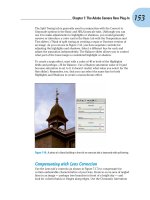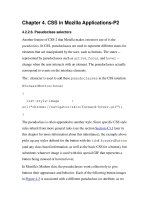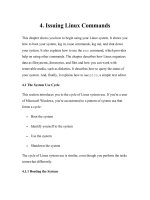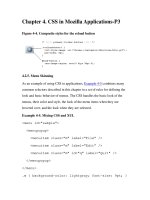Chapter 4 – Cryptography ppt
Bạn đang xem bản rút gọn của tài liệu. Xem và tải ngay bản đầy đủ của tài liệu tại đây (911.92 KB, 83 trang )
Security+
All-In-One Edition
Chapter 4 – Cryptography
Brian E. Brzezicki
Cryptography (77)
Cryptography – science of encrypting information.
–
“scrambles” data so only authorized parties can
“unscramble” and read data using two methods
•
Can substitute – change one letter with a different letter
•
Can transpose – scramble the order of letters, without
actually changing one for another.
–
The best cryptosystems both substitute and
transpose.
Visual next slide
Basic Idea
Cryptographic Terminology (77)
•
Cryptography - a method of storing and transmitting
data in a form only intended for authorized parties to
read or process.
•
Cryptanalysis* - science of studying, breaking, and
reverse engineering algorithms and keys.
(more)
Cryptographic Terminology (n/b)
•
Encryption – the method of transforming data
(plaintext) into an unreadable format.
•
Plaintext – the format (usually readable) of data
before being encrypted
•
Cipher text – the “Scrambled” format of data after
being encrypted
(more)
Cryptographic Terminology (n/b)
•
Decryption – the method of turning cipher text back
into
•
Encryption algorithm – a set or rules or procedures
that dictates how to encrypt and decrypt data. Also
called an encryption “cipher”
•
Key – (crypto variable) a values used in the
encryption process to encrypt and decrypt
(more)
Cryptosystem Definitions (670)
(n/b)
•
Key space – the range of possible values used to
construct keys
example:
if a key can be 4 digits (0-9)
key space = 10,000 (0000 – 9999)
if it can be 6 digits
key space = 1,000,000 (000,000 – 999,999)
•
Key Clustering – Instance when two different keys
generate the same cipher text from the same
plaintext
•
Work factor – estimated time and resources to
break a cryptosystem
Cryptography History (78)
Romans used a shift cipher called a “CEASAR” cipher.
Shift Ciphers simply shift characters in an alphabet.
(visual on next slide)
ROT13 / shift cipher
Go to to try
Transposition Cipher
Jumbles up the ordering of characters in a
message. The Spartans of Greece used a form
of this called the “Scytale” Cipher.
(visual on next page)
Scytale (77)
Vigenere Cipher (79)
Polyalphabetic Substitution Cipher – A more
advanced substitution cipher as it any letter can
have multiple letters substituted for it!
That is an A will not always map to an N
•
Harder to break!
Visual next slide
Vigenere Cipher
Question
•
So far which of the CIA triad does cryptography
provide? (so far)
•
Can Cryptography provide any more of the CIA
triad?
Encryption algorithm design Best
Practices (80)
•
Algorithms should be open to review. Why?
•
assume the attacker knows your
encryption/decryption algorithm. Why?
•
The only thing that should be secret in a
cryptosystem is the “key”
•
The larger the key space is, the more secure a
cryptosystem is, this is called “Key Complexity”
What is the key space again?
(more)
Encryption algorithm design Best
Practices (80)
•
Keys should be randomly chosen from the entire key
space. If I have a key that is six characters
consisting of 0-9 and A-Z.
–
Why would the key “000001” be a bad key to use.
•
Keys must be security distributed and storage /
accessed. Why?
•
A key should be retired after so many uses. Why?
Encryption Modes – Block (n/b)
Take the message and break it up into fixed sized
blocks, encrypt each block using the given key.
Visual next page
Block (ECB encryption) (n/b)
Block Encryption (n/b)
Problems with Block Encryption?
•
If a block has the same contents, the resulting
cipher text block will have the same cipher text.
Block Encryption Problems
Solving Block Encryption Problems
•
Often with block encryption, we include a value in
addition to the key that changes for each block, so
we don’t get repetitive cipher text blocks. This is
called Cipher Block Chaining (see next slide)
–
Initialization Vectors are used with the first block
in CBC
Cipher Block Chaining (n/b)
IV
Replaces IV
XORing (n/b)
XORing is a Boolean mathematical “function” which
creates an output bit based on two input bits. It
outputs a 1 IF and ONLY if one bit of input is 1 and
the other is a 0.
INPUT1 INPUT 2 XOR OUTPUT
0 0 = 0
0 1 = 1
1 0 = 1
1 1 = 0
Stream Encryption (n/b)
The “key” is used as a key stream generator, which
creates a series of bits each are is mathematically
combined with the bit stream of plaintext to produce
cipher text. This is done for small pieces of
information, or information not in blocks.
•
Keyboard input
•
Morse code
•
Any input that arrives one bit or byte at a time
(visual next slide)
Stream Encryption
Cipher Text Bit Keystream Bit Output Bit
0 1
1 1
1 0
0 1
1 XOR 1 = 0
Cipher text = 0









